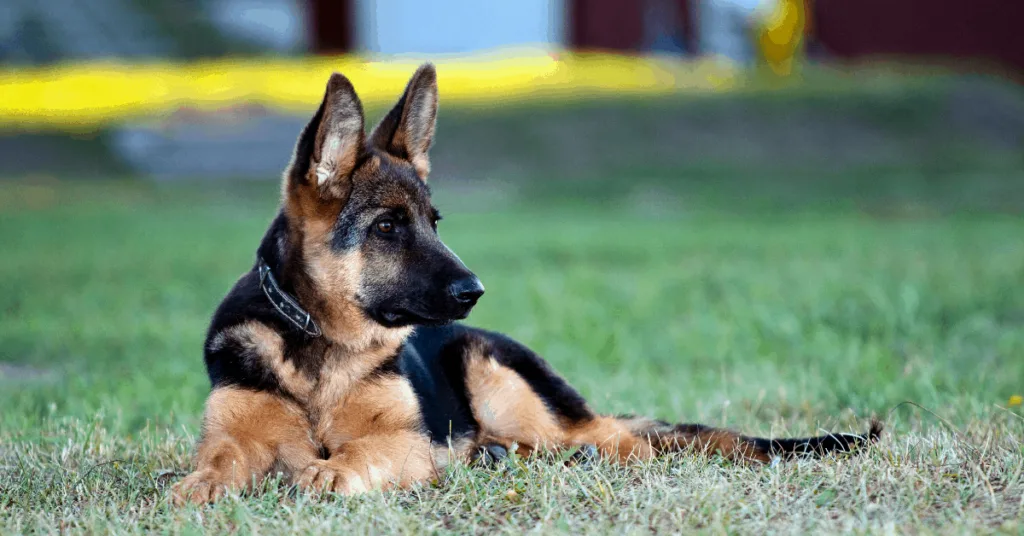
German Shepherds are among the most popular dogs in the United States. This is due to their great personalities, their loyalty to their families, and their ease of training.
But this doesn’t mean you’ll pick up your brand-new puppy and immediately have a well-trained and obedient dog. There are many steps required to get your GSD trained properly.
We’ll cover all of the German Shepherd training steps in detail below, plus give you lots of helpful tips to make your GSD training session more productive.
Click Here to Jump to a Section
Why Should I Train My German Shepherd?
Training a GSD is paramount to the happiness of your dog, your family, and the world your dog will travel through. A poorly trained GSD can become destructive, aggressive, and a total nightmare to be around.
Bad training can result in an angry or anxious German Shepherd who urinates in the house, tears up human belongings, or terrorizes the other pets in the house or neighborhood.
An untrained German Shepherd can cause havoc everywhere he goes. These big, imposing, and intelligent dogs have the ability to make everyone around them miserable if they do not receive the proper training.
On the flip side, a well-trained GSD is ab absolute joy to be around. They will gladly do any task you give them, and they will quickly ask for more instructions. They want to please, and they require a “job” of some sort to be truly happy and fulfilled.
Take the time to train your GSD, and commit to ongoing training to ensure your German Shepherd lives a long, happy, and healthy life.
When to Start Training a German Shepherd
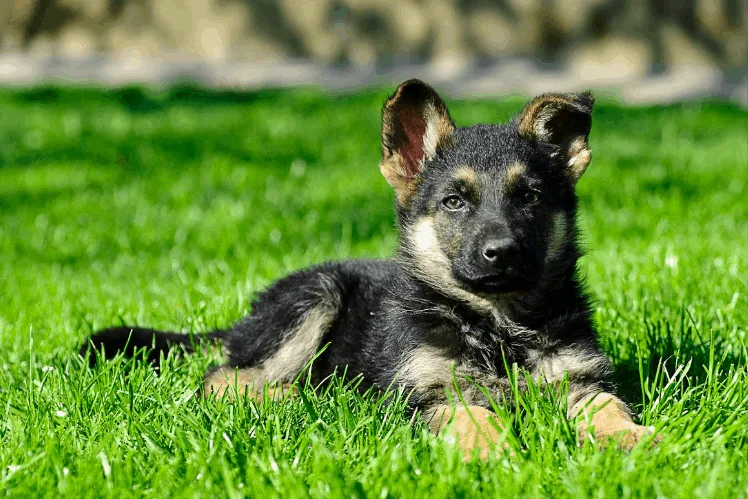
Ideally, you’d begin training your German Shepherd as soon as you bring her home. This is true whether you’re bringing home a new puppy or an adult GSD.
Training should begin slowly, but don’t delay. A big mistake is allowing time for the dog to “adjust to her new home”. It sounds sweet, but that well-meaning adjustment period could stretch much longer than you intended, resulting in a poorly-trained and misbehaving German Shepherd.
Training Isn’t What You Think
You may have read that statement above and thought of rigorous training sessions with whistles and discipline. Maybe you imagined grueling hours on the field running through drills.
While these things can be part of training a German Shepherd, they’re not the kind of training we’re talking about right now.
When your puppy or adult GSD arrives, you’ll want to begin training slowly and gently. These early days, while your dog is getting to know you and his new family, will lay the groundwork for more intense and focused training later.
Begin with simple requests and lavish praise when your dog obeys. At this early stage, you’ll be looking to teach your GSD the rules of your house.
If they’re allowed on the furniture, you must teach them this is okay. Conversely, if they will not be allowed on the furniture, you’ll need to teach this behavior right from day one.
The same goes for bathroom behaviors, sleeping arrangements, feeding schedules, and proper interaction with the humans and other animals in the house. It may seem like just being alive, but it is training at its most basic core.
Age Matters… or Does It?
I’m about to give you two conflicting statements but bear with me. Age matters when it comes to training a German Shepherd. But age also doesn’t matter. Here’s why.
There’s an old adage that states, “You can’t teach an old dog new tricks.” The meaning of this is that once someone or something reaches a certain age, they’re no longer able to learn new behaviors. This stems from the incorrect assumption that older people and animals will be stuck in their ways.
While it can be difficult to train an older dog (or person), it’s not impossible. Unless there is a physical reason why an older dog can’t do a specific trick or task, there is no reason why they can’t learn it.
That said, it’s definitely easier to train most puppies. This is why early intervention is important. A young German Shepherd will be primed and ready to learn. They will have lots of energy and be ready to please you.
But that doesn’t mean an older German Shepherd is impossible to train. It just takes a little more time, effort, and a few extra tricks.
The bottom line on age is that it matters only in the way you’ll train your German Shepherd. Just don’t give up on those older GSDs!
How to Train a German Shepherd
There are several types of training that every German Shepherd should go through.
These include basic socialization, basic obedience, and advanced obedience. These three training types will help your GSD be a respectful member of your family and learn his or her place in the pack quickly.
These are more advanced types of training that you can add later. These include various work-related training sessions such as guarding, sniffing, agility, and endurance.
Socialization: The First Training for German Shepherds
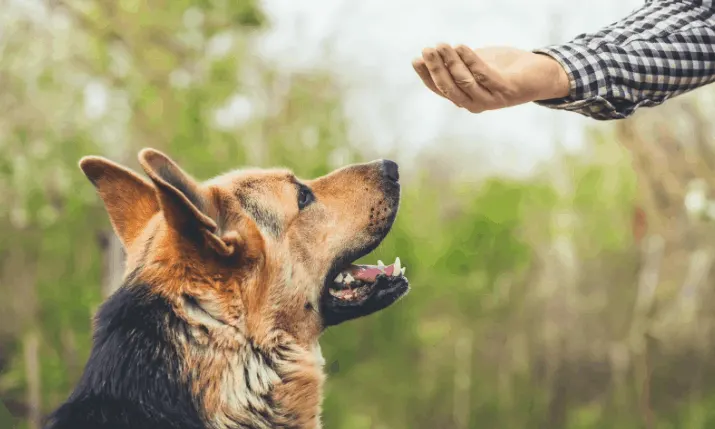
Socialization is, paws down, the most important piece of training you’ll ever give your dog. There is a narrow window of time when a GSD puppy is totally open to socialization.
While all dogs can eventually be socialized—with enough hard work and dedication—it’s the time between 12 weeks and 16 weeks that will result in the easiest and best social behaviors.
Socialization is important for all dogs, but GSDs are particularly in need of this type of training. They will eventually be big, powerful dogs.
Without proper socialization, they may turn aggressive or fearful, both behaviors that can quickly turn tragic.
Thankfully, GSDs are naturally social, intelligent, and loving dogs. They will be willing and able to learn all their socialization from you, no matter their age.
Basic Socialization for German Shepherds
Begin socializing your GSD by letting her get to know you and your family. This is easy to do—it involved just allowing your GSD to be a part of your everyday life.
Even if she appears to be snoozing by the couch, she is very much aware of what’s happening around her. She isn’t just sleeping. In fact, she is observing everything and everyone.
She is learning what’s normal household activities, how you and your family behave in a normal situation, and what she can expect in everyday life.
She will quickly come to be soothed by normal household sounds like the vacuum or dishwasher, and she won’t be bothered by neighborhood sounds.
She will also learn what’s unusual in your world. She’ll take her cues from you and your family to either ignore the knock on the door—say, from the main carrier—or become very alert to a stranger knocking unexpectedly.
Good vs. Bad Strangers
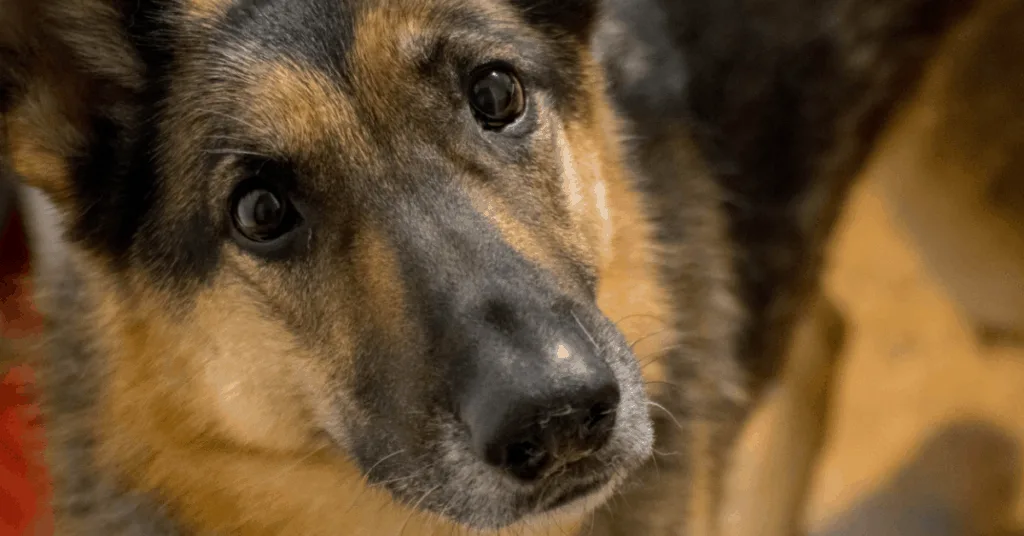
As mentioned above, your GSD will quickly learn who is a good guy and who may not be. Since he is taking all his cues from you, be sure you are responding appropriately to each interaction or potential interaction.
This means that you should remain calm when a “good stranger” is knocking or just walking by.
This is true for walks around the block or trips to the store, too. Your GSD will take her cues from you. If you are feeling threatened, she will respond in a defensive, threatening manner toward the person or thing that’s got you on edge.
This is very important to remember. Please don’t try to trick your GSD at this early stage: she won’t be able to tell the difference between pretending to be scared and you actually being scared.
To help your German Shepherd socialize properly, be sure you expose him to lots of different people, animals, and places.
He will need to learn that life is busy and full of many kinds of experiences. With you by his side, he’ll learn how to navigate this world with confidence and appreciation.
Confidence
I mentioned confidence just now, which might seem like a strange attribute to give to dogs. The fact is, all dogs need to feel confident in themselves and their family to be well-socialized.
A confident German Shepherd will not cower or behave in a threatening manner toward strangers. Likewise, a confident GSD will not allow a dangerous stranger to come too close or cause you harm.
Confidence during socialization training is a key to helping your GSD learn what’s safe, what’s questionable, and what’s likely dangerous.
A confident GSD will not hesitate to come to your defense, but she will also be wise enough to know that not all people or things are threats.
So, how do you raise a confident GSD? Exposure, praise, and setting consistent expectations.
It really is that simple. Be consistent in what you expect from your German Shepherd. Praise your GSD lavishly when she behaves as you expect. And, of course, continue to expose her to new and varied people, animals, places, and things.
Other Animals
Just as it’s imperative that you expose your dog to new people and places, you’ll also need to expose him to other animals.
During these interactions, he’ll learn that other dogs aren’t scary, cats aren’t for chasing, and that the birds in the trees aren’t planning nefarious deeds.
Showing a GSD that a cow or horse isn’t a threat will go a long way for German Shepherds who live in or visit rural areas.
Crate Training
It may not be immediately apparent, but crate training is part of socialization, and most dog experts agree that it’s an important part of all dogs’ early days.
Crate training gives your GSD a safe, secure, and private place to be alone, relax, sleep, or simply watch the household. A crate is a safe-haven for dogs, even if they put up a fuss in the beginning.
Crates add to your dog’s confidence, too. They will know they always have a safe place to go and rest when they need it, reducing anxiety and stress.
Housetraining for German Shepherds
Many new dog owners are anxious about housetraining. Honestly, it’s not that hard to do, and it’ll probably happen much faster than you think!
Most of the issues people face with puppies stem from a lack of understanding of how puppies work and what they need. For older dogs, it’s also about misunderstandings.
Housetraining can be quick, simple, and easy if you understand that puppies need many, many trips to the bathroom.
Older dogs won’t need as many frequent trips, but it can’t hurt to give them anyway. Puppies should be brought to the potty spot after every meal, after they drink, after a nap, and after playtime.
That’s a lot of bathroom breaks, but they have tiny bladders and very little control at this age.
For older dogs, you’ll be able to go longer between breaks, but you should still offer bathroom breaks every hour, if possible, to avoid any accidents.
Never scold or punish a dog of any age for potty accidents. They don’t understand why you’re angry, and this will only cause them to lose confidence and start to fear you.
Instead, figure out where you went wrong and correct the mistake. Did you wait too long after a meal? Did you miss your dog’s silent cues that a bathroom trip is needed?
Explaining Socialization Exposure for German Shepherds
You keep reading about exposure in this article, but I want to be sure we’re all on the same page. Exposure, when it comes to socializing German Shepherds, means safe and positive introductions to new things.
Never show your puppy or adult GSD something new and simply sit back to see what happens. That’s a recipe for disaster! Instead, be sure that all new exposures include a positive approach, praise, and most importantly your presence.
New exposure can include things such as new surfaces: concrete, wood shavings, sand, and grass, for example. It can include new sounds: birds chirping, lawnmowers, cars on the road, children playing, construction sounds.
New, positive exposures should include a huge variety of smells, too: all kinds of animals, people of all ages, foods, even garbage or other unpleasant things.
Social Distancing and Isolation Won’t Hamper Your Dog’s Socialization
I know it might be hard to believe, but social distancing (due to Covid-19 at the time of this article’s creation) and other kinds of isolation doesn’t have to be the end of your dog’s socialization training.
For sound exposure, you can play recordings of a variety of things: crowds, the ocean, forest noises, city noises, household noises that may not be common in your house.
You can go to Youtube and find just about anything and everything you could imagine. Simply play these sounds for your s and give lots of praise for calm behavior.
Check out this video of habituation sounds for puppies. Videos such as these can be extremely helpful as a training aid to acclimate your GSD to some of the many sounds that she will for sure encounter in the real world:
The same is true for sights and smells. This might be a bit trickier, but there are ways around social distancing and isolation practices. Plan trips to low-population areas during times when even fewer people might be around.
The smells of the people from earlier in the day will still be strong, so your dog will get the benefit of sensing these. You can also order things online, finances allowing, and let your German Shepherd spend time exploring the items.
Another option is taking your GSD for a ride in the car. Even though you won’t be able to touch or physically interact with the world, you’ll still be showing your German Shepherd lots of new sights, sounds, and smells.
Basic Obedience
Basic obedience will include commands that will help teach your German Shepherd proper behaviors at home and out in the world.
When you begin basic obedience training, you’ll be showing your GSD what you expect of him, which will increase his relaxation and happiness overall.
A German Shepherd who doesn’t know his place will be anxious, aggressive, or destructive. So, don’t skip this step!
Basic Obedience Includes:
- Sit. Your dog will sit on command, no matter what’s happening around him.
- Stay, hold, or wait. Your GSD should stay in the spot you leave him, without inching toward you or breaking the hold command early.
- Come. Your dog should come immediately when called.
- Down. Your dog should lay down on command, no matter what’s happening around her.
- Drop-it. This is an often overlooked but important command that makes your dog drop anything he or she just picked up.
Each of the above commands will help keep your GSD safe in the world. A well-timed “stay” or “hold” can stop an excited puppy from running into a busy street, for example.
How to Train Your Dog to Sit
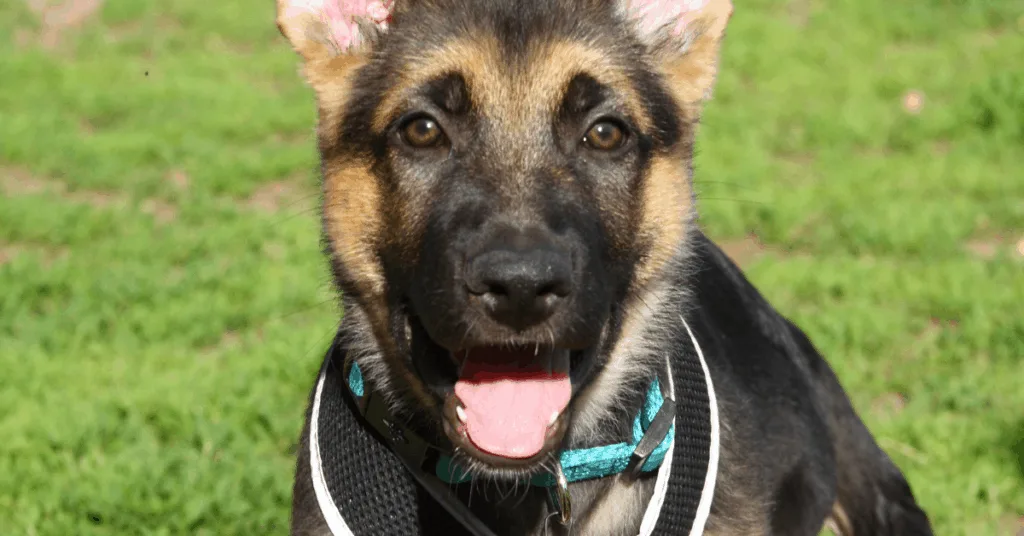
The sit command is very easy to train. Here’s how.
- Hold a small training treat in your hand—you may even wish to show the dog what you’re doing. Most GSDs will quickly learn the sound of the treat bag.
- Hold the hand with the treat close to your dog’s nose, but don’t let her have it yet. She’ll be able to smell it in your fist, so it’s often easiest to hold onto it loosely.
- Once you have her attention, slowly move your hand toward her forehead. If this works, your dog will follow your hand with her nose. This movement makes her lower her backend to the floor.
- As soon as her bum touches the floor, say “Sit” and give her the treat. This is the time to flood her with praise.
Eventually, she’ll anticipate the sit command and simply sit before you have to move the treat. Ideally, she’ll hear the word “sit” and just do it. But this can take time and patience.
Continue to use this “lure” technique until you see her anticipating the command.
How to Train Your Dog to Stay
For this command to work properly, you’ll need to choose a release command. Most people say something like “OK” or “release”, but any single word will do.
The first step is to teach the release word. That may seem counterintuitive, but trust me on this one.
Show your dog a treat, then toss it a few feet away. The moment he takes a step toward the treat, say your release word. Repeat this over and over. He’ll begin to associate that word with something good.
Next, ask him to sit. Facing him, pause just a moment, then give the treat. However, do not allow him to get up. He must remain in the sit position.
If he gets up, ask him to sit once more, pause briefly and say “stay”, then give a treat. After he understands that he is not to move, you may start saying the release command as you hand him the treat.
Next, ask him to sit, give the stay command, then take a small step back. Maintain eye contact. If he stays sitting, give him the release command and a treat.
You can gradually increase the time you wait but only take that one step back for now.
Once he’s comfortable with a short-distance stay, you can gradually increase the distance you step back. Once he’s out of reach, use the release command and have him come get the treat from you.
If he gets up before you release him, that’s totally fine. This simply means he isn’t comfortable sitting and waiting that long yet. Go ahead and reduce the distance or time between the sit and release commands.
How to Train Your Dog to Come
Possibly the easiest thing to teach a dog is to come when called. It’s as simple as saying her name and handing her a treat.
Do this up close and sitting on the floor with her at first. She should be near you, playing or being groomed. Say her name, and if she looks at you, give the treat.
Try not to say her name over and over again. She’ll learn to ignore it, and that’s the opposite of what we want to do.
Once she looks at you consistently when you say her name, you can add the “come” command. Take a step away from her, say her name and “come”, and as soon as she moves toward you, give the treat.
You can do the come command at any time, giving her lots of opportunities to come when called. You can combine the come command with sit, down, and stay, too.
How to Train Your Dog to Lay Down
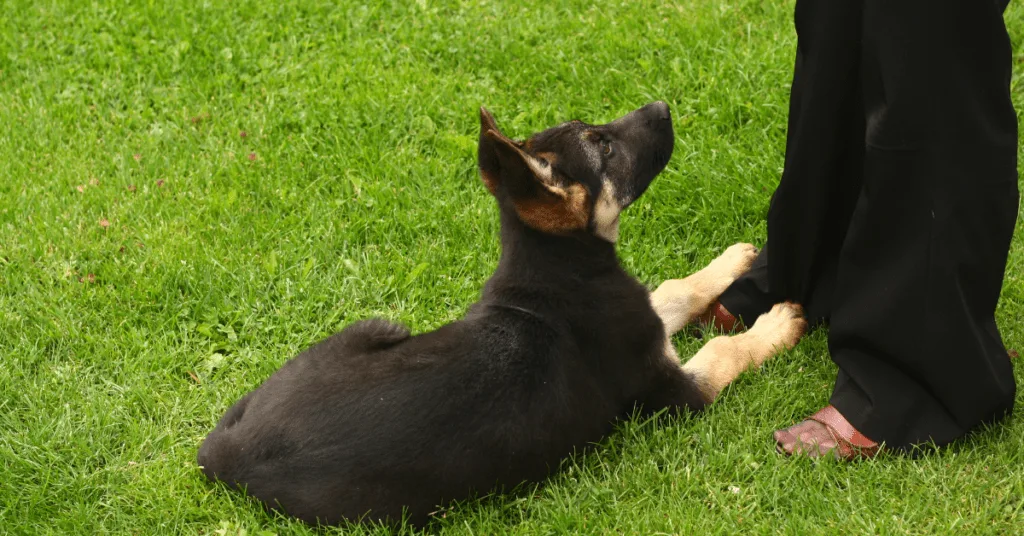
The easiest way to train a dog to lay down on command is to simply wait for them to do it, say the command “down”, and then give a treat. Over time, he will come to associate the command with his natural actions.
You can also teach a dog to lay down on command by using the lure method—as discussed above in the sit section. Instead of holding the treat up by his forehead, you’d move the treat down to the floor, right between his front paws.
How to Train Your Dog to Drop It
This is one of the tougher basic commands to teach. Most puppies will want to chew whatever they pick up, and they won’t be too keen on giving up their prize. Older dogs may not mind as much, but they might be a bit grumpy losing out on their cool find.
However, teaching “drop it” could save your dog’s life. If they happen to pick up something toxic or dangerous, a quick drop it command could keep them from a rush trip to the vet.
Unlike the other commands in the basic training list, you do not want to do this using a treat. The treat will be her reward for dropping the item!
- Use a favorite toy. Say, “take it” or “here” and let her have the toy.
- Let her have fun with it for a moment or two, but don’t wait too long. If you wait too long, she may get bored and the training won’t stick.
- While she is still chewing on or playing with the toy, hand her a treat and say “drop it”.
- The moment she drops the toy and takes the treat, praise her and repeat “drop it”.
- Continue to do this several times a day until she associates the command with actually dropping a toy. Make sure to use different toys each time so she doesn’t associate it with the command.
After some time, you’ll be able to give this command anytime, anywhere, no matter what she’s chewing on, and she will drop whatever it is.
Be sure to give lots of praise and treats for this behavior, as it goes against their nature to simply drop a coveted item. You’ll need to be sure the reward is well worth losing the toy!
Advanced Obedience
All of the advanced obedience training is designed to fine-tune your dog’s basic obedience and further secure her good behavior.
Advanced training includes performing all of the basic commands in a variety of new locations and with lots of new distractions.
Start easy and go into your own fenced yard, if you have one. If not, you can do advanced training in a park or on the sidewalk, too. Just try to start out during a time when it’s not very busy.
You can gradually start advanced training in busier places to help solidify your dog’s confidence.
Advanced training also includes off-leash training in safe, dog-friendly environments.
Be sure your dog knows all of the basic commands first, and that she will perform each one 100% of the time before you try any off-leash commands outside of your home or yard.
Hand Signals
Advanced training also includes hand signals, which allow you to give commands without making a sound.
To do these, you simply add the hand signal to your regular training routines. Over time, you can lower your voice, and eventually, you’ll say nothing at all and only use the hand signal.
A great benefit of using mostly silent hand signals for commends is that your dog will have to pay attention to you at all times so he doesn’t miss a command.
Since German Shepherds want to please you, they won’t mind at all staring at you all day, waiting for the next hand signal.
Additional Advanced Training
You can make things a little more complex for your GSD when it comes time to advance her training.
You can combine commands, such as sit, stay, down, and come all in succession. Switch it up and do them in a different order each time to keep her on her toes.
You can try sit, down, and stay while you’re out of sight. You may also wish to teach your dog to refuse treats from strangers or even family members if you give the stay command.
Commanding your dog to sit or lay down while in motion can be tricky but fun—give it a try!
Work-Related Training: Guard Duty, Sniffing, Agility, Endurance
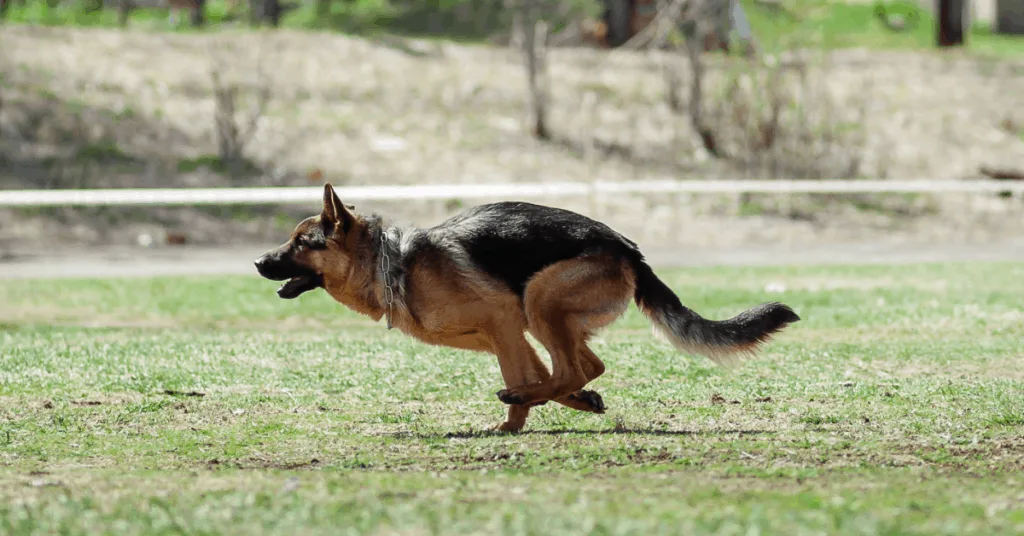
This type of training for a German Shepherd includes any advanced of complex activities they may need to perform either as a job or just as a more complicated and rewarding playtime with you.
Work-related training can include anything from cool acrobatic tricks on an obstacle course made for agility training, to sniffing practice to find specific items—think drug-sniffing dogs.
If you want your German Shepherd to help protect your property, it’s wise to teach them guarding behaviors such as patrolling and alerting.
It’s important to train him to behave this way only when commanded to or only at specific times—such as when you’re not home.
Endurance activities can include running, walking, patrolling behaviors. It can also include pulling weights, such as sledding or similar activities.
For any of the work-related training, be sure to give your dog plenty of rest time, too. This is tough work, and even though he may love every second of it, he’s going to need time to rest, recharge, and relax. Keep tough training sessions short.
Final Thoughts
Even though many new German Shepherd owners dread certain parts of training, it’s not actually that hard. All training is based on natural behaviors your dog probably already exhibits to some degree.
Good training simply isolates those desired behaviors and amplifies them through rewards and praise.
Training your dog doesn’t have to be all about work though. Make sure training sessions are short, frequent, and full of fun.
Your GSD won’t even know you’re teaching him new skills. He’ll only care that you’re spending so much time with him!
